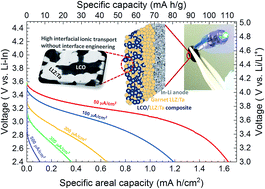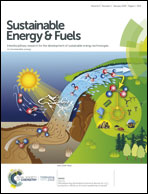A garnet structure-based all-solid-state Li battery without interface modification: resolving incompatibility issues on positive electrodes†
Abstract
The development of high-performance Li7La3Zr2O12 (LLZO)-based all-solid-state lithium batteries (SSLB) is usually hampered by highly resistive interfaces due to the need for sintering at elevated temperatures to form ionic diffusion paths through the grains. Many strategies have been proposed to solve the problem but the achievements have been limited. Herein, a new design principle is introduced, based on co-sintering crystalline LCO and Ta-substituted LLZO instead of using the more reactive Li–Co–O precursors and Al-substituted LLZO, which allows the fabrication of high specific areal density and low cell area resistance without the interface modification of LLZO-based SSLB. Detailed studies using micro-Raman and EDS mapping revealed that the well-sintered interfaces are free from detrimental secondary phases. To demonstrate that a true bulk-type SSLB can be constructed by this straightforward strategy, the material loading for a composite positive electrode was increased to about 10 times that in previous reports, which resulted in a high areal capacity of 1.63 mA h cm−2 (i.e. 110 mA h g−1) when discharged with a current density of 50 μA cm−2. It also allows one to discharge the fabricated SSLB at a very high current density of 500 μA cm−2 at 50 °C due to the minimized cell areal resistance. The new fabrication strategy for the LLZO-based SSLB paves the way for achieving SSLB with high safety and energy density.



 Please wait while we load your content...
Please wait while we load your content...